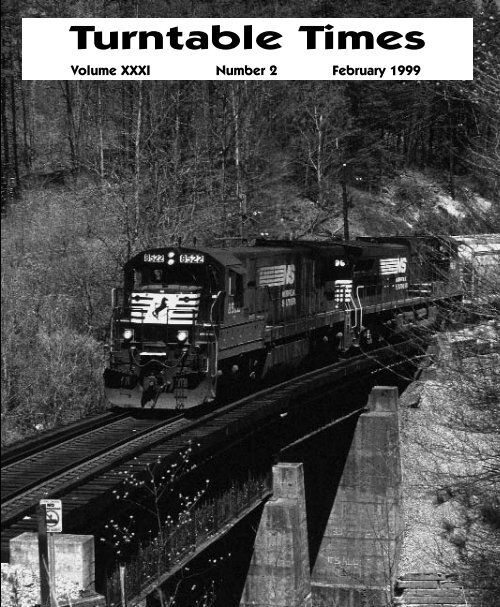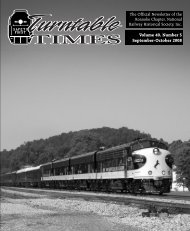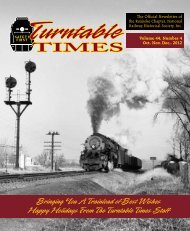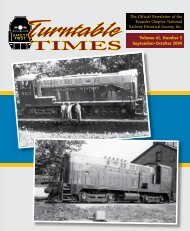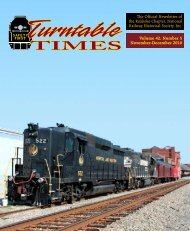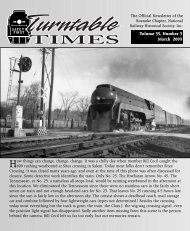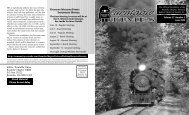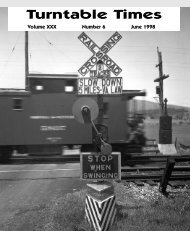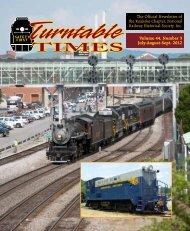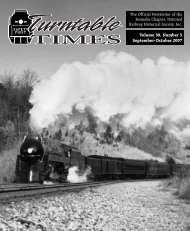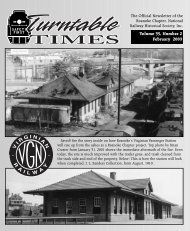February 1999 - Roanoke Chapter National Railway Historical Society
February 1999 - Roanoke Chapter National Railway Historical Society
February 1999 - Roanoke Chapter National Railway Historical Society
You also want an ePaper? Increase the reach of your titles
YUMPU automatically turns print PDFs into web optimized ePapers that Google loves.
Turntable TimesVolume XXXI Number 2 <strong>February</strong> <strong>1999</strong>
Turntable TimesVolume XXXI <strong>February</strong> <strong>1999</strong> Number 2Editor .................................... Kenney KirkmanMixed Freight .......................... Robin ShaversSmall Rails ............................... Dave MeasheySplinters ........................................ Bill ArnoldPublisher ............................... Richard D. ShellPublisher ...............................Kenneth L. MillerAll materials should be sent directly toEditor Kenney Kirkman590 Murphy RoadCollinsville, VA 24078-2128Turntable Times is printed by Salem Printing Co., Salem, VACards and FlowersIf you know of a <strong>Chapter</strong> Member who is sick,lost a loved one or has a new birth in the family,please contact Elizabeth Leedy. Elizabeth isresponsible for <strong>Chapter</strong> cards and flowers andcan be reached at 389-5274.Meeting NoticeThe <strong>Roanoke</strong> <strong>Chapter</strong> of the <strong>National</strong> <strong>Railway</strong><strong>Historical</strong> <strong>Society</strong> will hold its next generalmeeting on Thursday, <strong>February</strong> 18th, <strong>1999</strong> at7:30 pm. The meeting will be held at the FirstPresbyterian Church on the corner ofMcClanahan and Crystal Spring Avenue in<strong>Roanoke</strong>.Meeting Cancellation PolicySince it’s that time of year, as a reminder wehave the following policy regarding inclementweather.The general meeting will be considered cancelledif any of the following conditions are met:<strong>Roanoke</strong> City Schools are closed on the day ofor the day after the meeting, or Virginia Westernnight classes are cancelled for the night of ameeting.Cover PhotoRichard Shell caught Norfolk Southern 8522heading up a southbound grain train near Wirtz,Virginia on a beautiful spring day in April 1997.Richard D. Shell photo.Deadline for Turntable TimesThe deadline for the next issue of TurntableTimes is Thursday, <strong>February</strong> 18th, <strong>1999</strong>. Pleasesend articles, information and exchangenewsletters to: Kenney Kirkman, 590 MurphyRoad, Collinsville, Va. 24078-2128.Small Rails - <strong>February</strong>by Dave MeasheyThe <strong>Roanoke</strong> Valley Model Engineers havecontinued working on improvements totrack and scenery on the modules at their temporarydowntown location. New members havejoined the club, some of whom cannot makeTuesday night meetings. To allow everyone achance to work on the modules, the club isalternating work nights. One week the club usesTuesday night as a work night, the next week ituses Wednesday night.The Big Lick Big Train Operators have suspendedmeetings for the bad weather months,as is their custom. Individual members still keepbusy with other projects, however. One memberis working on his indoor layout, addingstructures and additional track. Another memberis working on his second Maine two-footerlive steam locomotive. Several of us are kitbashingboxcars for a contest which will be judgedduring one of our spring meetings. The there’sthe stuff that just needs to be fixed for the next“tour of duty” outdoors.Mixed Freight - <strong>February</strong>by Mr. Robin ShaversMany of you are familiar with the half hourbroadcast on public TV known asTRACKS AHEAD. This on again, off again weeklyfeature on railroading and model railroading hasbeen on the airwaves for a number of years.There is another half hour program that focuseson railroading period called ALL ABOARD. It toois a weekly show featured on public TV. In theRichmond viewing area, it can be seen onPage 1
Thursday nights at 9:00 p.m. TRACKS AHEAD isusually scheduled for 3:00 p.m. on Saturdayafternoon. In addition to the above mentionedregularly programs, I’ve also seen a number ofprograms on railroading on The LearningChannel and The Discovery Channel. To keepthese features coming and maybe increasing innumbers, please call and or write to the stationor network that presents these programs. Letthem know there is indeed an audience for suchprograms. This is especially important whereadvertisers are concerned. Most of the programsI’ve observed are entertaining and informative.Though some of the information given isvery basic for those of us within the hobby orprofession, it has to be this way for the viewinggeneral public that is no as educated about railroadingas most railroad enthusiast are.The Second Annual North Carolina Rail Fair isscheduled to occur the second weekend ofMarch 99. The dates are March 13th & 14th withthe location being The North Carolina StateFairgrounds in the W. Kerr Scott Building from9:00 a.m. til 5:00 p.m. on Saturday and from10:00 a.m. til 3:00 p.m. Sunday. I attended theevent last year and left satisfied. This is an eventinvolving the sale of model railroad merchandiseand railroadiana. For more information, callCharles Miller at 703-536-2954 or Sid Suggs at803-532-5912. e-mail: alabar9@aol.comCloser to home, last winter Trains Unlimited ofLynchburg offered a series of free and open tothe public clinics covering various aspects ofmodel railroading usually held on Saturday afternoons.They are doing it again this winter. Theclinics will continue thru March. Contact TrainsUnlimited at 804-239-8377 or 800-728-3850 orlog into members.aol.com/trnsunltd/ You mayalso want to inquire about the <strong>National</strong> ModelRailroad Association’s Mid-East RegionConvention being held in Lynchburg on April23rd and thru 25th.Our comrades at the Historic Spencer Shopshave recently put voice mail to work for them tomake things easier for callers. The new numberis 704-636-2889 which replaces all the previousPage 2numbers for the different departments.With the anticipated increase of freight traffic,the proposed higher speed passenger trainsand less than acceptable numbers of gradecrossing accidents, a number of grade crossingsalong the former Southern <strong>Railway</strong> betweenGreensboro and Charlotte, N.C. are beingclosed or alterated. This is especially true forSalisbury and Spencer. Some crossings will havetheir safety appliances upgraded. Some will becamera equipped to video tape motorist whomdrive around lowered gates.Telling About Our Railroad Heritageby Dave MeasheyOne day during the week after Christmas, Itook some track and a train to theSunshine Station nursery school, where my wifeteaches, and put on an exhibit for the children.The exhibit’s mission was twofold: I shared thefun of model railroading. But I also told the childrensomething about the trains and howimportant they were to the building of ournation - which fits in with the mission of theNRHS.It was not that hard to do. Setting up took themost effort. But the enjoyment those childrengot from watching the train made the effort wellworth my time. It also gave me an opportunity totalk to the children about how important thesteam trains were, and how important today’strains are. I used a long spout engineer’s oil canas a pointer, while I told the children about eachcar and the kinds of goods they would haul. Ialso used the oil can to point out the differentparts of the locomotive and tell what they werefor. I didn’t use highly technical terms, but I didn’t“talk down” to the children either. I had tokeep my presentation short for groups ofyounger children, who had less attention spanthan those children who were almost kindergardenage.I also explained why steam locomotive engineerswore the soft billed hats and goggles. Itold them how the high-cuffed gauntlet glovesprotected from heat, and sometimes from cold.
I also explained how the red bandanna wasused to keep dust and coal dust out of anengineman’s mouth and nose. Simple stuff to us,but grand mysteries revealed for these children.We all had fun, and perhaps the seeds wereplanted to grow future railfans and model railroaders.U.S. Railroad Retirement Board andGenealogical Information The U.S. RailroadRetirement Board administers a Federal retirementbenefit program covering the nation’s railroadworkers. The records that the RRB maintainsdeal primarily with the administration and paymentof these benefits. The Board will provideinformation from its records on deceased personsfor the purpose of genealogical research.However, the RRB will not release information onany living person without the written consent ofthat person. The Railroad Retirement Board, likethe Social Security Administration, was notestablished until the mid-1930’s, and it beganmaintaining its own records of all covered railservice in 1937. So the Board’s service recordsare limited to individuals who worked in the railindustry after 1936. If a person was not actuallyworking for a railroad after 1936, he or shewould not be listed in these records. Nor wouldthe Board generally have any pertinent recordson persons whose rail service was performedon a casual basis or was of short duration. Also,the Board’s records pertain only to personswhose employers were covered under theRailroad Retirement Act. Employers such asinterurban, suburban, or street electric railwaysare not covered under this Act.The Board’s records are filed under the railroademployee’s social security number, and aperson’s social security number often appearson his or her death certificate. In some cases, ifthat number is not available, a records searchcan be made by using the employee’s full name,including the middle name or initial, and thecomplete dates of birth and death. However, indealing with relatively common surnames, apositive identification number may not be possiblewithout the employee’s social securitynumber.Requests for genealogical information shouldbe sent directly to: Railroad Retirement Board,Office of Public Affairs, 844 North Rush Street,Chicago, Il 60611-2092. The fee for searchingRRB records is $16 for each employee on whomrecords are requested. A check or money orderfor this amount should be made payable to theRailroad Retirement Board. This fee must be paidbefore any search is attempted. It is not refundable,even if the information requested cannotbe located or if the file has been destroyed.Generally the Board requires at least 30 to 60days for a complete reply to genealogicalinquires. You may request further information viathe Internet at: http://www.rrb.gov/geneal.html(Above from The Automatic Block, WesternMaryland <strong>Chapter</strong>, NRHS).Rail SaleAmtrak has unveiled an on-line discountticket program, “Rail Sale.” Passengersnow may purchase reserved seats for selectedone-way Amtrak coach seats at a substantial discount.The program is only available on theinternet at http://reservations.amtrak.com RAILSALE tickets can only be purchased with a creditcard. Tickets can be sent by mail or picked-upat a staffed Amtrak station. In addition, Amtrakhas started a Rail SALE e-mail newsletter, providingcustomers with ongoing updates andreminders of special discounts. Subscriptionrequests can be entered at the above webaddress. Rail SALE fares are valid only forreserved coach seats on Amtrak service in theU.S. (Potomac Rail News, Potomac <strong>Chapter</strong>,NRHS).The RPO, Sorting at 60 MPHby Jim WhitmoreHow dangerous could life get for a <strong>Railway</strong>Post Office clerk? Well, the answerdepends on what year you’re talking about.Now 1893, that was a dangerous year. Only6,645 RPO clerks were employed by the PostOffice Department that year, but they livedthrough or died in 403 train collisions, derail-Page 3
ments, fires and explosions. The PostmasterGeneral”s annual report for that year spends nofewer than 30 pages itemizing the destructionand death on the RPO’s, and the reasons for thenear-daily accidents.But the RPO clerks - whose daily grind, in theearly years, could be a death-defying act - hada more succinct explanation. As one clerk wrylyput it: “A wreck is usually caused by one traintrying to pass another on the same track. It hasnever been done successfully, but the railroadskeep on trying. Sometimes a train will get off thetrack and run along the ground. That has neverworked very well either.”The fact is, the railroad companies - someof which claimed they could make more moneyhauling pig iron - were dragged kicking andscreaming into the mail-moving business. Theythumbed their nose at the Postmaster General’srepeated pleas for faster service and modifiedroutes. And they added injury to insult by providingthe Department with rolling stock thatnowadays would be labeled “unsafe at anyspeed”.In the words of one historian, RPO cars “wereof flimsy wood construction, often rebuilt formother coaches scrapped as too old...One crew(found it impossible) to report their car’s lengthas required, because it was inches shorter goinguphill than when level.” In a serious crash, themail cars would splinter like sheaves of kindling.Despite these hazards, mail by rail progressed.The <strong>Railway</strong> Mail Service moved from“closed pouch” rail transport in the 1830’s to“open pouch” sorting en route beginning in1864.The first official “open pouch” <strong>Railway</strong> PostOffice ran between Chicago and Clinton, Iowa.And as the RPO network expanded, the speedof mail service in the United States increaseddramatically. <strong>Railway</strong> Post Offices were soonheralded as one of the wonders of the age.Of course, the foot-soldier, the nomadicworkhorse of this historic enterprise, was therailway mail clerk. Many of the first RPO clerkswere veterans of the Civil War. And the <strong>Railway</strong>Post Offices - whose ranks remained exclusivelyPage 4male right through 1977 - were operated fromthe outset with military-like discipline and precision.Even modern-era clerks recall the rigors of theRPO. “We were sort of like the Marines of thePost Office Department”, reminisces GlenWester, a veteran of the Memphis & Dallas linewho last rode the rails in 1955. “We were a veryproud outfit. And it was very tightly run...veryspit-and-polish as far as following all the rules.Demerits were handed down for everythingfrom failing a scheme examination to missing amail drop. “There were probably 50 things youcould get demerits for”, says Wester, “and onlyone or two things that got you a merit.”Adding to the RPO clerk’s mystique were hisever-present RPO badge and 38-caliber Smith &Wesson “banker’s special”.Modern-era RPO veterans downplay theimportance of their guns, “(The Revolver) wasmore a deterrent than a real weapon”, insistsone RPO veteran. “It probably wouldn’t hold upaccurately for more than twenty feet.” Anotherformer clerk referred to his .38 caliber as a “littlepea-shooter”.In the old days, by contrast, RPO clerks tooktheir weapons very seriously. Trains were frequentlyheld up by road agents and harassed bywarring Indians, and clerks defend the mailswith their lives.The March 1889 Scribner’s Magazine reportedan incident in Arkansas where “the robbers,before visiting the postal car, had secured$10,000 for the express safe. When they came toClerk R.P. Johnson, he suggested they hadsecured booty enough, and that under the circumstancesthey might let the mail matter alone.The masked men agreed.”As recently as 1921, the Postmaster Generaldescribed mail train robberies as “a nationalepidemic”, and President Harding assigned U.S.Marines to guard the RPO’s. The troops wereissued orders that said, “you will carry your pistolin your hand at all times”, and “When youshoot, shoot to kill.” Not surprisingly, the railwaycrime wave ended in short order.Indeed, by the 1920’s and 1930’s, the RPO’s
had settled into a predictable and productiveroutine. Robberies were less common. Andwith improvements such as air brakes and doubletracks, and rail cars made of steel, accidentswere less destructive and less frequent.Even the “routine”, however, had a certainadventure to it on the RPO’s. For newcomers,there was the challenge of “getting your RPOlegs.” That is, conquering motion sickness and,in the words of Washington & Florence veteranTommy Clifton, “learning how to rock and rollwith the train while you’re pitching mail.”(Another RPO veteran claims that, thanks to hisyears on the trains, “I didn’t get seasick like mostguys when I went overseas during World WarII.”)Clerks also faced the challenge of staying alertand on their feet for as many as sixteen hours ata stretch. “Mail lock coffee” - so called becauseit was ready to drink when it was thick enoughto float a mail lock - helped a lot. So did thesteady onslaught of deadlines: what one clerkcalled “working under the gun.”While the train thundered ahead at 60 to 80miles an hour, the clerks sorted mail into hundredsof pouches and slots that lined the sidesof the mail car. Pouches were dispatched ateach town along the route, and local mail wascontinually taken on board for sorting.Of course, the trains did not stop at everytown, so many mail drops and pickups had tobe accomplished “on the fly”. The exchangewas a one-two maneuver, executed in a splitsecond.The RPO car’s V-shaped “catcher arm” wouldsnatch the mail pouch off a specially-designedpost. And, nearly simultaneously, a clerk standingin the RPO car’s open door would throw outa pouch of freshly-sorted local mail.It could sometimes be a dangerous procedure.There were countless incidents where thecatcher arm snagged not the mail pouch, asintended, but another train or a building. Thestory is also told of a clerk who, while waiting tomake an exchange at Port Washington, Ohio,sneezed his denture out the door.The engineer would usually alert RPO clerks toPage 5an approaching station with a long blast on thetrain’s whistle. But more often than not, theclerks knew where they were based on landmarksand “feel”.Frederick Puckett of Asheville, Ohio told RPOhistorian B.A. Long about a fellow clerk “whoalways knew when he was approachingHaverhill, Ohio, because he would see an oldwhite horse standing the same spot. One daythe horse was not there, having died, and theclerk missed the exchange.Another clerk is said to have set an empty bottleon the floor during the last leg of his route.When it fell over, he knew that train had roundedthe final curve and was close to the depot.Of course, until the final years, RPO clerksworked in a world without zip codes. Theirscheme knowledge was a web of colorfulplace-names like Claystick, Tobosco, Nashport,Pleasant Valley, Dillon and Zanesville (the townson the old Baltimore and Ohio line going eachway out of Newark, Ohio). The mail was somethingpersonal, and it was treated with a nearsacredsense of mission.RPO clerks also took great pride in theirbreadth of their scheme knowledge. They oftenhad a near perfect command of six to eightschemes at a time. “Those fellows were likehuman computers”, recalls Tommy Clifton. “Theywere examined a regular basis, and consideredit a disgrace to fail one of those exams.”“The men were completely devoted toadvancing the mail”, says RPO authority ArnoldPetersen. “They were dedicated to finding thefastest available dispatch - constantly examiningthe schedules and finding ways to move themail faster.”Yet, for all his high-minded sense of duty andmission, the typical RPO clerk was a rugged,down-to-earth man.He worked in cramped, dirty, noisy conditions- cheek-by-jowl with as many as twentyother clerks in a 60-foot RPO car. Heating, lightingand ventilation were poor and unreliable.“It was a hard life”, recalls Glen Wester. “Youwere away from home much of the time. Yourhours had to conform to the train schedule.”
Norfolk and Western PhotoOne of the N&W <strong>Railway</strong> Post Office Routes over the years was on trains 3 and 4. On a sunny April 2, 1954, agleaming number 602 leads an eight car “Pocahontas” eastbound near Montvale, Virginia. The RPO is the secondcar in the consist. On the diner, second car from the rear, one of the cooks is taking a break before the lunchcrowd begins on what would seem to be a fairly light train on this date.The majority of assignments were night runs. The <strong>Railway</strong> Mail Service reached it’s highAnd at the end of the line, more often than not, point in the years immediately following Worldwere a strange city and cheap hotel for a few War II. The RPO’s boasted 1,500 routes, 30,000hours sleep. (There were also consolations. employees and 4,000 railcars. They handled theAfter several of those long runs a clerk might get great bulk of non-local mail, and were the backboneof the American postal system.off for as long as a week at a time.)Page 6
In the 1940’s and 1950’s, however the nation’stransportation system underwent radicalchanges. The advent of commercial airlines,interstate highways and affordable automobilesall spelled doom for the old-time network ofpassenger trains.The number of trains available for mail transportationdropped steadily from 2,600 in 1956to 1,400 in 1961 and 741 in 1967. And as theinfrastructure of trains and rail facilities shrunk,the RPO’s had to be cut back accordingly.The last RPO run took place on June 30, 1977,between New York and Washington, closing thebook on one of the most colorful episodes inU.S. Postal Service history.For the last RPO clerks, it was a time of greatsadness and - in some cases - bitterness. Theyhad taken great pride in their work. And,despite the rigors of their job, they remainedfiercely loyal to the RPO way of life.“We had a special exprit de corps, a specialcamaraderie. We all worked together, andnobody was up (finished) until everybody wasup”, says Clifton. “But on the same token, on theRPO’s you could be your own man.”The last RPO run is only a few years behind us.But the <strong>Railway</strong> Post Office already seems a thingof a bygone era. To a remarkable extent, the RPOclerk - like the Pony Express riders and the pioneersof air mail - has become an object of nostalgiaand even glorification. There is no harm inromanticizing the RPO clerk - some of them,after all, were heroes and legends.But the truth about the RPO clerk is both simplerand grander: he was, by and large, an intelligentbut unpretentious worker who happenedto take enormous pride in moving the mail. Assuch, he remains an example to all of(Above story via The Bulletin, Bridge Line<strong>Historical</strong> <strong>Society</strong>; The Tower Topics, Utica &Mohawk Valley <strong>Chapter</strong>; The Green Block,Central New York <strong>Chapter</strong>; The Timetable, LakeShore <strong>Chapter</strong>; The Orderboard, Tampa Bay<strong>Chapter</strong>, from an article originally appearing inthe May-June 1991 issue of Postal Life.)Turntable Times is published monthly as the newsletter of the <strong>Roanoke</strong> <strong>Chapter</strong>, <strong>National</strong> <strong>Railway</strong> <strong>Historical</strong> <strong>Society</strong>, Inc. Opinions and pointsof view expressed herein are those of the staff members of the Turntable Times and not necessarily reflect those of the members, officersor directors of the <strong>Chapter</strong>. Items of interest should be sent to Editor Kenny Kirkman, 590 Murphy Road, Collinsville, VA 24078-2128.Editor, Turntable Times<strong>Roanoke</strong> <strong>Chapter</strong> NRHSP.O. Box 13222<strong>Roanoke</strong>, VA 24032-1322Non-ProfitOrganizationU.S. PostagePAID<strong>Roanoke</strong>, VAPermit No. 89


